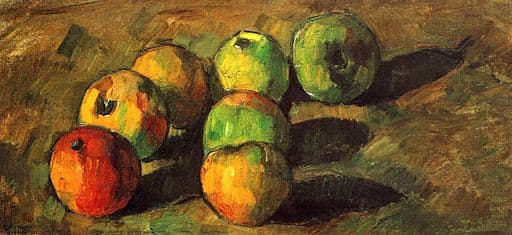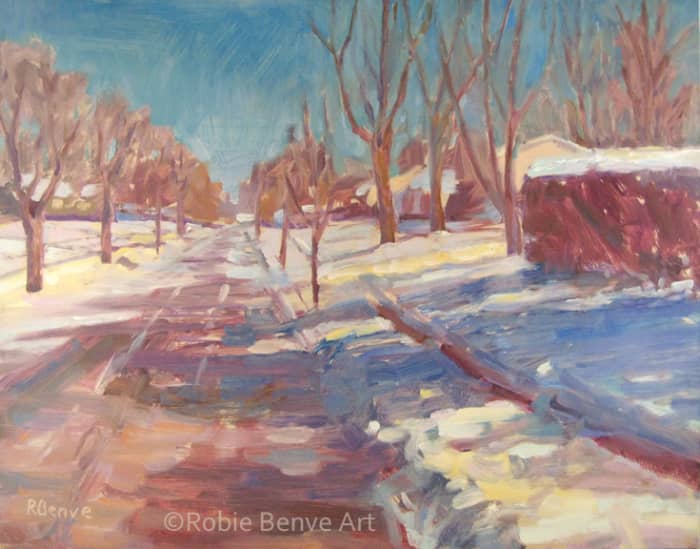Elements of Art Line and Value in Painting Landscape
Robie is an artist who loves sharing what she has learned about fine art and painting in the hope that it might help other creatives.

Lines and shapes are essential elements of painting. Larn how you to employ them to affects the limerick and overall feeling of the painting.
Robie Benve
Vocabulary of Art
The essential elements in fine art expression are:
- Line
- Shape
- Blueprint
- Value
- Form
- Color
By applying them consciously to a called medium, the artist can control the artistic consequence and embody concepts.
The noesis and understanding of the elements of art offer to an creative person the keys that unlock the doors to successful compositions.
In this article, we are focusing on the offset two, line and shape.

Great use of line and shape limerick in this still life by Paul Cézanne.
Paul Cézanne [Public domain or Public domain], via Wikimedia Commons
Lines and Shapes: The Skeleton of Creative Composition
A good artwork is not made by photographic likeness, but rather by a expert composition.
Skillful structural arrangement is extremely important for any blazon of painting or drawing, and how you use lines and shapes strongly affects it.
Shapes in Compositions
Each area of color can be seen as a shape. Shapes are easier to visualize if you focus on the masses of different value or tone.
If you squint looking at a picture you'll exist able to see beyond color variations and notice how details blend together and create simpler masses of similar value.
Squinting simplifies shapes and unifies value variation into few basic masses: lightest, heart, and darkest value. Being able to "see" this way is very useful for planning your composition and making some preparatory sketches.
You can await at the values in a painting or drawing and divide them into few value categories, from the lightest to the darkest. Sometimes you can identify 4 or more degrees of value, but the more yous simplify the ameliorate for your composition.

How lines and shapes intersect and separate the film plane determines the structure of your painting. Photo: Spring Is Just Around The Corner, oil, by Robie Benve.
Robie Benve Art
Masses of Lite or Dark tone make Value Shapes

Value shapes of the limerick can exist seen easier when the photo is digitally desaturated. If you squint now they will be fifty-fifty more evident.
Ringlet to Continue
Read More From Feltmagnet
Lines in Compositions
Lines are much more than the contour of objects.
When looking at whatever artwork, each edge between different colors or different shapes tin can be seen as a line.
Either used as a contour or as an edge between different paint colors, lines ascertain shapes and can exist used by the artist to guide the eye of the viewer through the painting.
Artists desire the viewer'south center to be carried to the focal point and, at the same fourth dimension, not get "stuck" there.
Lines are a great style to guide the viewer's attending to different areas around the picture. Recall of tree branches, tall grasses, roof edges, landscape variations, value shifts, they all create lines that guide the eye effectually the painting.
So, lines not only ascertain objects but too determine the composition of the painting.
Lines tin be used to communicate a sense of motion, free energy, or stillness.
It is very important to exist aware of lines, and information technology is non and so easy to grow awareness of how some lines can be distracting or fifty-fifty ruin a composition.
Edges of Shapes Read equally Lines
Areas of different value class the primary shapes of the composition.
To see them fifty-fifty better you can take a photograph of the artwork and digitally eliminate colour. When you lot look at a blackness and white image all you see are value shapes.
Each shape has edges, and our brain reads edges as implied lines. The second thumbnail below indicates the unsaid lines with red strokes.
Visualize the Lines in the Mural


Types of Lines in Painting
Your goal as an artist is to employ the lines in the limerick to direct the viewer's eyes to the focal point and keep information technology moving within the picture.
In that location are iii major directions lines:
- Horizontal
- Vertical
- Diagonal
How they are used and how many times they echo transport a message to the viewer.
Lines can exist:
- Round and organic.
- Straight and geometric.
Man-made objects take a lot of horizontal and vertical straight lines, especially at ninety-degree angles. This does non happen in nature.
Energy and Perception of Lines
| Horizontal | Vertical | Diagonal |
|---|---|---|
| Stable | Stable | Unstable |
| Rigid | Rigid | Dynamic |
| Rest | Formal | Motion |
| Static | Strong | Energetic |
| Implies cessation of move | Hopeful | Leads the middle speedily from one point to another |
| Anchored by gravity | Cheerful | Restless motion |

Corking use of diagonals in the action of The Washing of the Feet, while the horizontal and vertical elements convey at-home and thoughtfulness.Rembrandt 1640-1649, pen and brown ink on newspaper.
Rembrandt, Creative Commons
Some Lines Are Bad for Compositions
Generally speaking, you are better off fugitive these types of lines:
- Lines pointing straight to a corner of the motion-picture show: it takes the eyes of the viewer out, never to come dorsum.
- Continuous lines cutting the painting across horizontally. Typically the viewer enters the painting from the bottom left. Horizontal lines, when they are continuous, create a barrier for the eyes to continue and look at what is above them. Make sure yous create a gap on those lines, either by interruption or alter in value.
- Angles pointing to the side of the frame. They work like arrows, and while if the angle is pointing to the focal indicate it encourages the viewer to wait at the "hot spot", if it points to the edge, the viewer may get directed out of the picture, to the painting hanging next to yours!
Keep It Balanced
The good rule of pollex, like for anything else in life, is to use common sense and aim to create balance and unity in your artwork.
Don't lose the focus on your big idea: what are y'all trying to represent? What kind of feeling do you want to convey?
Keeping the big motion-picture show in listen will help decide the kind of lines and shapes that volition work best in your work. Try to include different types of lines, some organic, some directly, vary their angle, colour, size, and brush marks.
In the same style, strive for a remainder of sparse pigment and thick paint; sharp edges and lost edges; intense colors and dull colors; etc.
The more than you think about residue in your design, the more successful your painting.

Amazing use of shape and lines past Edgar Degas (1838-1917) successfully keeps the focal indicate on the ballerina and keeps the optics of the viewer moving around the moving picture
Edgar Degas [Public domain], via Wikimedia Commons
Great Book on Painting Composition - One Simple Dominion, Many Ways to Employ Information technology
This content is accurate and true to the all-time of the author'due south noesis and is non meant to substitute for formal and individualized advice from a qualified professional.
Questions & Answers
Question: How do artists apply line, shape, and course in their artworks?
Answer: The principal purpose to use line, shape, and form is to define the subject affair and provide the needed information in the painting.
Artists learn to visually organize those elements in ways that create strong compositions.
The placement, direction, and value of each element influences how the viewer's eye moves around the painting.
More on what makes a good composition in this article
https://feltmagnet.com/painting/Value-Pattern-Hurting...
© 2013 Robie Benve
Robie Benve (writer) from Ohio on July 30, 2016:
I edited the info on lines, adding some more details, hopefully making it more than clear. Cheers for your valuable feedback!
alona on July 27, 2016:
lines is not clear to me :(
Robie Benve (author) from Ohio on August 01, 2014:
Hi The Dirt Farmer, yous are admittedly correct: one time you train the eye to see lines and shapes in fine art, y'all acquire to appreciate it in different ways that go across the field of study matter represented. Thank you a lot for your comment, share, and vote! :)
Jill Spencer from United states on August 01, 2014:
Skilful basic information for affectionate artwork, too. I am going to take to read this again! Shared & voted up.
Robie Benve (writer) from Ohio on March 25, 2013:
Hello beingwell, sometimes life takes over and our hobbies and passions take the dorsum seat.
Try to break the ice with a small, piece of cake project, it worked for me a few years dorsum. I painted a children's field of study for my daughter's sleeping accommodation - I said, I'm non buying that painting for y'all, mommy tin make you ane. And I did. And I never stopped painting from there.
All-time wishes to you! Thanks for stopping by! :)
beingwell from Bangkok on March 22, 2013:
I used to love painting. Somehow, I forgot why I stopped.
Robie Benve (author) from Ohio on March 05, 2013:
Hi torrilynn, thank you a lot for your annotate, I'm glad you plant information technology informational and useful. :))
Robie Benve (author) from Ohio on March 04, 2013:
Yous are so correct carol, while I paint I have a piffling voice in my head that wants to remind me all the time what's important. Information technology'due south kind of abrasive, but very useful, information technology goes "Value, value, value, value...."
Thanks!
torrilynn on March 02, 2013:
Hi Robie,
thanks for this hub.
very informational and useful for whatever and everyone
who is willing to learn the skill of painting.
voted upwards
carol stanley from Arizona on March 01, 2013:
getting the values right is the most challenging. If that doesn't work the painting doesn't. Always a challenge for me. Groovy job every bit e'er. Pinning.
heimbachvared1954.blogspot.com
Source: https://feltmagnet.com/painting/The-Elements-of-Painting

0 Response to "Elements of Art Line and Value in Painting Landscape"
Post a Comment